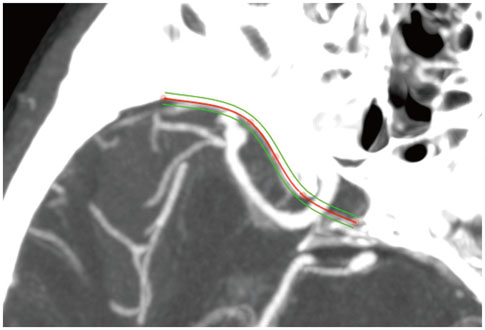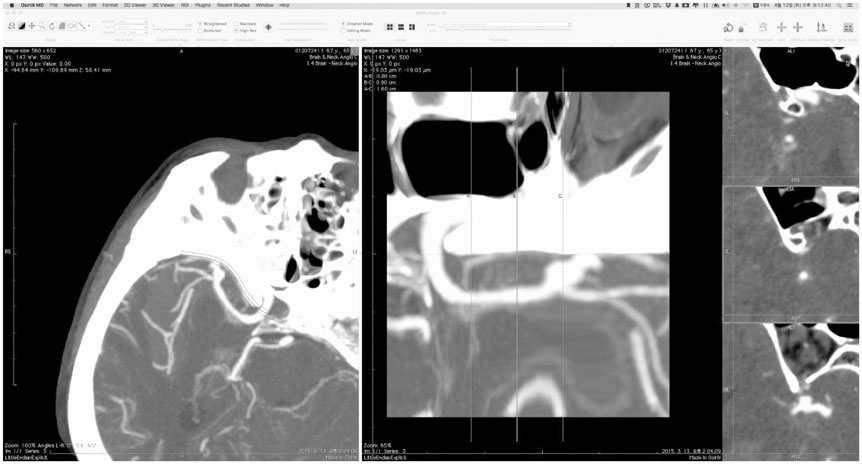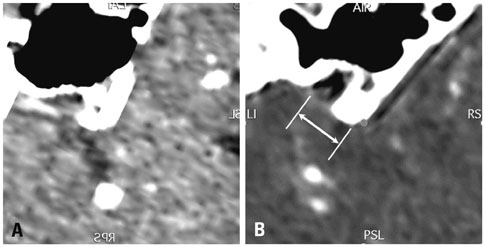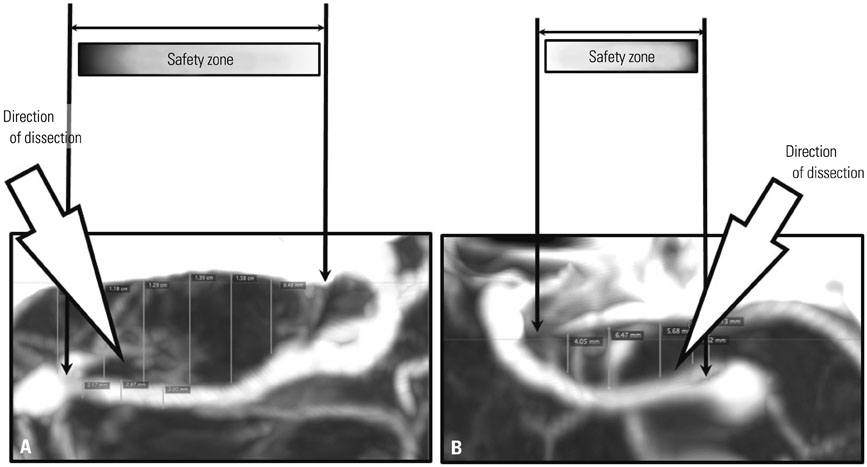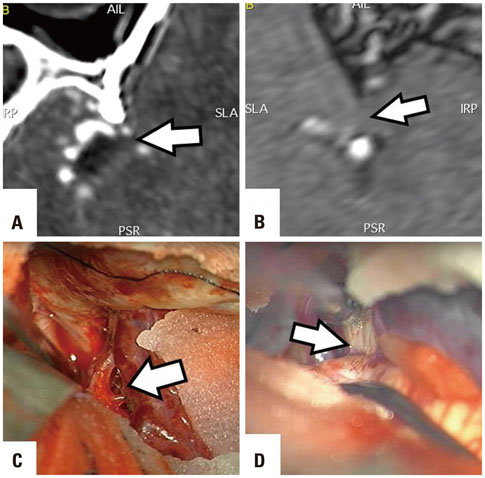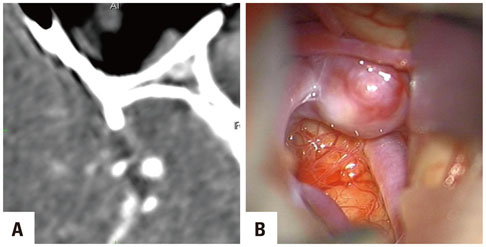Yonsei Med J.
2017 Jan;58(1):241-247. 10.3349/ymj.2017.58.1.241.
Use of Three-Dimensional Curved-Multiplanar Reconstruction Images for Sylvian Dissection in Microsurgery of Middle Cerebral Artery Aneurysms
- Affiliations
-
- 1Department of Neurosurgery, Chung-Ang University Hospital, Seoul, Korea. cuttage@cau.ac.kr
- 2Department of Radiology, Chung-Ang University Hospital, Seoul, Korea.
- KMID: 2374212
- DOI: http://doi.org/10.3349/ymj.2017.58.1.241
Abstract
- PURPOSE
The purpose of this study was to introduce a method of using three-dimensional (3D) curved-multiplanar reconstruction (MPR) images for sylvian dissection during microsurgical treatment of middle cerebral artery (MCA) aneurysms.
MATERIALS AND METHODS
Forty-nine patients who had undergone surgery for MCA aneurysms were enrolled. We obtained the 3D curved-MPR images along the sphenoid ridge using OsiriX MDâ„¢ imaging software, compared sylvian dissection time according to several 3D MPR image factors, and investigated the correlations between these images and intraoperative findings.
RESULTS
Utilizing preoperative information of the sylvian fissure (SF) and peri-aneurysmal space on 3D curved-MPR images, we could predict the feasibility of sylvian dissection for a safe surgery. 3D curved-MPR images showed several features: first, perpendicular images to the sylvian surface in the same orientation as the surgeon's view; second, simultaneous visualization of the brain cortex, vessels, and cisternal space; and third, more accurate measurement of various parameters, such as depth of the MCA from the sylvian surface and the location and width of the SFs.
CONCLUSION
In addition to conventional image studies, 3D curved-MPR images seem to provide useful information for Sylvian dissection in the microsurgical treatment of MCA aneurysms.
MeSH Terms
Figure
Reference
-
1. Yaşargil MG. Microneurosurgery. New york: Thieme-Stratton;1984.2. Lawton MT. Seven Aneurysms: Tenets and Techniques for Clipping. New York: Thieme;2011.3. Ngando HM, Maslehaty H, Schreiber L, Blaeser K, Scholz M, Petridis AK. Anatomical configuration of the Sylvian fissure and its influence on outcome after pterional approach for microsurgical aneurysm clipping. Surg Neurol Int. 2013; 4:129.
Article4. Huh SK. [Microsurgical anatomy of the middle cerebral artery]. J Korean Neurosurg Soc. 1998; 27:1769–1773.5. Perneczky A, van Lindert E, Müller-Forell W, Fries G. Keyhole concept in neurosurgery. New York: Thieme;1999.6. Harland SP, Hussein A, Gullan RW. Modification of the standard pterional approach for aneurysms of the anterior circle of Willis. Br J Neurosurg. 1996; 10:149–153.
Article7. Hernesniemi J, Ishii K, Niemelä M, Smrcka M, Kivipelto L, Fujiki M, et al. Lateral supraorbital approach as an alternative to the classical pterional approach. Acta Neurochir Suppl. 2005; 94:17–21.
Article8. Lan Q, Gong Z, Kang D, Zhang H, Qian Z, Chen J, et al. Microsurgical experience with keyhole operations on intracranial aneurysms. Surg Neurol. 2006; 66:Suppl 1. S2–S9.
Article9. Mitchell P, Vindlacheruvu RR, Mahmood K, Ashpole RD, Grivas A, Mendelow AD. Supraorbital eyebrow minicraniotomy for anterior circulation aneurysms. Surg Neurol. 2005; 63:47–51.
Article10. Mori K, Osada H, Yamamoto T, Nakao Y, Maeda M. Pterional keyhole approach to middle cerebral artery aneurysms through an outer canthal skin incision. Minim Invasive Neurosurg. 2007; 50:195–201.
Article11. Yamahata H, Tokimura H, Tajitsu K, Tsuchiya M, Taniguchi A, Hirabaru M, et al. Efficacy and safety of the pterional keyhole approach for the treatment of anterior circulation aneurysms. Neurosurg Rev. 2014; 37:629–636.
Article12. Elsharkawy A, Niemelä M, Lehecčka M, Lehto H, Jahromi BR, Goehre F, et al. Focused opening of the sylvian fissure for microsurgical management of MCA aneurysms. Acta Neurochir (Wien). 2014; 156:17–25.
Article13. Ogilvy CS, Crowell RM, Heros RC. Surgical management of middle cerebral artery aneurysms: experience with transsylvian and superior temporal gyrus approaches. Surg Neurol. 1995; 43:15–22.
Article14. Pritz MB, Chandler WF. The transsylvian approach to middle cerebral artery bifurcation/trifurcation aneurysms. Surg Neurol. 1994; 41:217–219.
Article15. Dashti R, Hernesniemi J, Niemelä M, Rinne J, Porras M, Lehecka M, et al. Microneurosurgical management of middle cerebral artery bifurcation aneurysms. Surg Neurol. 2007; 67:441–456.
Article
- Full Text Links
- Actions
-
Cited
- CITED
-
- Close
- Share
- Similar articles
-
- Superior Temporal Gyrus Approach to Middle Cerebral Artery Aneurysms
- Direction of Middle Cerebral Artery Bifurcation Aneurysms and Surgical Approach
- Two Indices Affecting the Directions of the Sylvian Fissure Dissection in Middle Cerebral Artery Bifurcation Aneurysms
- Surgical Management of Middle Cerebral Artery Aneurysm
- Multiple Aneurysms on the Same Bifurcation Site of the Middle Cerebral Artery

